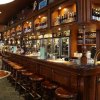Bierbrasserie Cambrinus
Localização
Philipstockstraat 19, 8000 Brugge, / , Bélgica - CEP
Horários
Todos os dias, de 11h às 23h.
Cervejas
Cardápio completo
The history of Cambrinus – King of Beer
Cambrinus, often mentioned in student songs, is known as the King of Beer ( long before Bud ) in Belgium, the Netherlands and Germany as well as in other European countries.
In this historical building, dating from 1699, he is portrayed two times. The first time as a statue sitting on a large vat, holding a foaming mug of beer in his hand, on the corner of the façade. The second time engraved in a glass window on the side of the house, again sitting on a vat and accompanied by a lady.
Throughout the times he has often been identified as Jan I Primus, Duc of Brabant. He is said to be the inventor of the Brussels’faro and lambic. In any case, he is a legendary king, to whom people have accredited the invention of beer.
A Germanic tribe, known as ‘Gambrivii’and mentioned by the Roman historian Tacitus, could also be at the origin of his name. Another version tells that he was the Lord of Cambrai ( now in France, but previously part of Flanders, known as ‘Kamerrijk’) and that Cambrinus would then be the latin version of his title. The title of King of Beer was first accredited to Cambrinus by the Nuerenberg poet BUHARD WALLIS.
Despite the fact that he shows up twice in this building, we have found no prove as such his name had ever been used for naming the tavern that has been here for a long time.
We do know that it was called ‘Au Casino’and ‘Caves de Munich- Café des Trois Suisses (1887), later on known as ‘Café Amiraute’ and ‘Louvre’(1942). Since 1987 it housed the restaurant ‘The Fox’.
Apart from the statue of Cambrinus, there are other sculptures that can be seen on the frontside of the house. Top down we can see the Devil, The Sun and the Moon.
On the first floor, from left to right, we see :
Venus, roman godess of love, representing Spring
Ceres, godess of agriculture, representing Summer
Bacchus, god of wine, here he represents Autumn
Diana, godess of the hunt and the moon, representing Winter
The house, that was build in 1699, has a very worldly façade for pietous Bruges.
Cambrinus, often mentioned in student songs, is known as the King of Beer ( long before Bud ) in Belgium, the Netherlands and Germany as well as in other European countries.
In this historical building, dating from 1699, he is portrayed two times. The first time as a statue sitting on a large vat, holding a foaming mug of beer in his hand, on the corner of the façade. The second time engraved in a glass window on the side of the house, again sitting on a vat and accompanied by a lady.
Throughout the times he has often been identified as Jan I Primus, Duc of Brabant. He is said to be the inventor of the Brussels’faro and lambic. In any case, he is a legendary king, to whom people have accredited the invention of beer.
A Germanic tribe, known as ‘Gambrivii’and mentioned by the Roman historian Tacitus, could also be at the origin of his name. Another version tells that he was the Lord of Cambrai ( now in France, but previously part of Flanders, known as ‘Kamerrijk’) and that Cambrinus would then be the latin version of his title. The title of King of Beer was first accredited to Cambrinus by the Nuerenberg poet BUHARD WALLIS.
Despite the fact that he shows up twice in this building, we have found no prove as such his name had ever been used for naming the tavern that has been here for a long time.
We do know that it was called ‘Au Casino’and ‘Caves de Munich- Café des Trois Suisses (1887), later on known as ‘Café Amiraute’ and ‘Louvre’(1942). Since 1987 it housed the restaurant ‘The Fox’.
Apart from the statue of Cambrinus, there are other sculptures that can be seen on the frontside of the house. Top down we can see the Devil, The Sun and the Moon.
On the first floor, from left to right, we see :
Venus, roman godess of love, representing Spring
Ceres, godess of agriculture, representing Summer
Bacchus, god of wine, here he represents Autumn
Diana, godess of the hunt and the moon, representing Winter
The house, that was build in 1699, has a very worldly façade for pietous Bruges.



